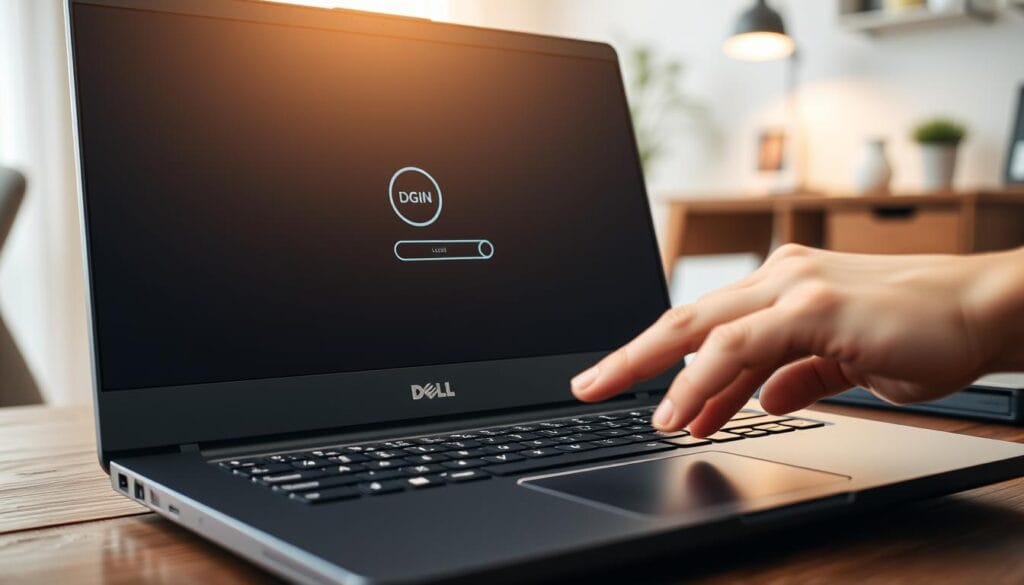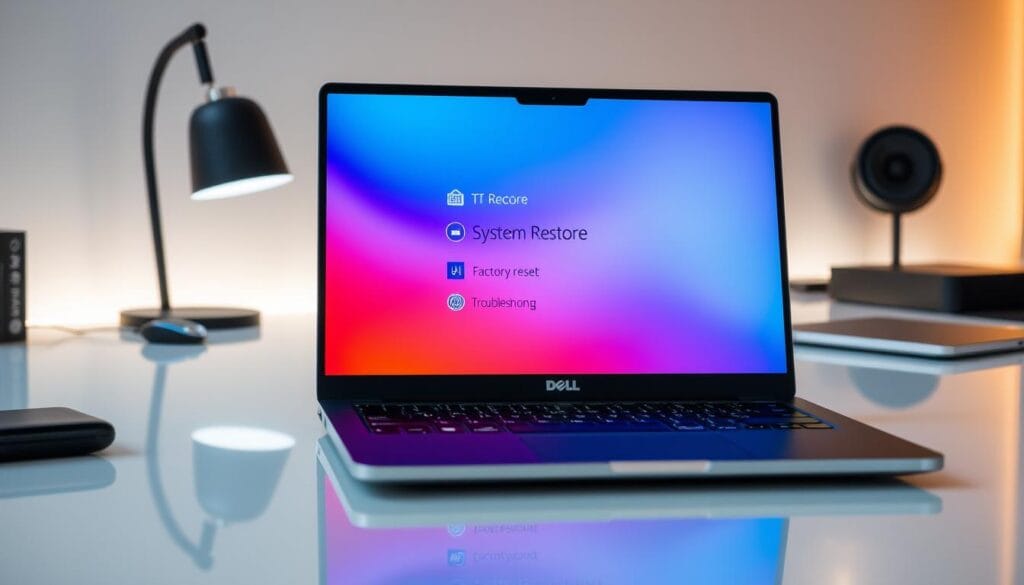Table of Contents
Are you wondering how to reboot Dell laptop? Using your Dell laptop, you might need to restart it sometimes. This could be for updates, fixing performance, or solving small problems. Learning how to reboot your Dell laptop is key to keeping it running well and lasting longer. It’s easy to do with a few simple steps.
Rebooting your laptop might seem hard, but it’s really simple. Restarting your Dell laptop can help fix many issues. With the right help, you’ll reboot your Dell laptop with ease.

This guide will show you why restarting your Dell laptop is important. You’ll also learn how to do it safely in just a few steps. Soon, you’ll be able to restart your Dell laptop like a pro.
Key Takeaways
- Rebooting your Dell laptop is a simple process that can help resolve common issues.
- You can restart Dell laptop to install software updates, troubleshoot performance issues, or resolve minor glitches.
- Knowing how to reboot your Dell laptop is essential to maintaining its performance and extending its lifespan.
- You can easily learn how to reboot Dell laptop by following the steps outlined in this guide.
- Rebooting your laptop can help you get a fresh start and improve its overall performance.
- By following the proper steps, you can safely restart Dell laptop without losing any important data.
Understanding Your Dell Laptop’s Reboot Options
Knowing how to reboot your Dell laptop is key for troubleshooting. The reboot process can seem complex, but it’s vital to pick the right method. This prevents losing data or damaging your system. You’ll learn about standard and force restarts and when to use them.
Starting the troubleshooting process is easy if you know the basics. Always save your work and close apps before rebooting. This simple step can save you a lot of trouble later on.
Standard Reboot vs. Force Restart
A standard reboot is the safest choice most of the time. But, if your laptop won’t respond, you might need a force restart. Knowing the difference between these methods is crucial to avoid harming your system.
When to Choose Each Method
Use a standard reboot when your laptop works fine and you can shut it down normally. For a frozen or unresponsive laptop, a force restart is better. Remember, force restarting can erase data, so back up your files often.
Safety Precautions Before Rebooting
Before you reboot, save your work and close all apps. This keeps your data safe and ensures a smooth reboot. Also, back up your important files to prevent loss if something goes wrong.
By understanding reboot options and taking safety steps, you can fix your Dell laptop confidently. Always prioritize data safety and take steps to avoid losing data during the reboot process.
How to Reboot Dell Laptop: The Standard Method
To restart Dell laptop, start by clicking the Start menu. It’s at the bottom left of your screen. Then, go to power options and pick restart. This easy method works for most users.
For a quicker way, use keyboard shortcuts. Press Windows key + X and choose Shut down or sign out. Then, select Restart. You can also use the Windows Quick Access menu by clicking the Windows logo in the corner.
Here are some tips for a smooth restart Dell laptop process:
- Save any open documents to prevent data loss
- Close any unnecessary programs to free up system resources
- Unplug any external devices to prevent any potential conflicts
By following these steps and tips, you can how to reboot Dell laptop quickly and safely. Always save your work and close programs before restarting. This helps avoid any issues.
Protecting Your Data During the Reboot Process
Before you reboot your Dell laptop, it’s key to protect your data. This is very important if you’re rebooting for Dell laptop reboot process troubleshooting. Save any open documents and mark unsaved work to avoid losing data.
Make sure to back up your important files. Use an external hard drive or cloud storage. Regular backups are crucial for Dell laptop troubleshooting. They help you recover data if something goes wrong during the reboot.
Saving Open Documents
First, save any open documents and close apps you don’t need. This helps avoid losing data and makes the reboot smoother.
Backing Up Important Files
Then, back up your key files to an external drive or cloud storage. This ensures your data is safe, even if reboot issues arise.
Checking for Updates Before Restart
Lastly, check for any system updates before restarting. This keeps your laptop up-to-date with the latest software and security, reducing reboot risks.
By taking these steps, you can safeguard your data and reboot successfully. Always prioritize data safety during Dell laptop troubleshooting. If unsure, seek professional help for the Dell laptop troubleshooting process.
For a safe and efficient reboot, always focus on data protection. Follow these precautions to avoid data loss and keep your Dell laptop running well.
Force Restart Methods for Unresponsive Systems
When your Dell laptop won’t turn on, it can be really frustrating. It can mess up your work or fun time. First, try simple fixes like checking the power cord and battery.
Identifying the right force restart method is key to avoid losing data or damaging your system. Press the power button for 10-15 seconds to force shut down. Or, if your laptop has a removable battery, take it out and put it back in to restart.
For Dell laptops with special keyboard combos, press Ctrl + Alt + Del to restart. Remember, force restarting should be a last choice. It might cause data loss or system problems. Always try simple fixes first.

To prevent these issues, keep your Dell laptop updated and well-maintained. By using these force restart methods and tips, you can fix problems and use your laptop smoothly again.
Some important things to remember for force restarting your Dell laptop include:
- Try basic troubleshooting steps before force restarting
- Use the power button or removable battery method
- Utilize specific keyboard combinations for Dell laptops
- Regular maintenance and updates can prevent unresponsive systems
Dealing with Common Dell Laptop Boot Issues
When your Dell laptop has boot problems, it can really upset your day. You might see a black screen or find it won’t start. These issues can come from software bugs, hardware failures, or damaged system files.
To fix these problems, finding the main cause is key. If you see a black screen, try starting in safe mode or restore to a working state. If your laptop won’t start, check the power cord and battery.
Common Boot Issues and Solutions
- Black screen: Restart in safe mode, update drivers, or perform a system restore
- BIOS error messages: Update BIOS, reset BIOS settings to default, or contact Dell support
- Boot loop: Disable fast startup, update drivers, or perform a clean installation of the operating system
Knowing the causes and fixes for these issues helps prevent them. Keep your system updated, run disk cleanups, and manage drivers for a smooth start.
Always back up your files and documents to avoid losing them during a reset. If you’re not sure about troubleshooting, check the manual or call Dell support for help.
Recovery Options After Failed Reboots
When your Dell laptop won’t reboot, it can be really frustrating. It can mess up your work or fun time. Luckily, there are ways to fix it. You can use the Dell laptop system restore to go back to when it worked fine.
To start the system restore, first, boot into the Windows Recovery Environment. Press the F11 key a few times until you see the Windows Recovery Environment screen. Then, choose “Troubleshoot” and click on “System Restore” to start the recovery.
You can also use Dell SupportAssist OS Recovery. It’s built into your Dell laptop and offers many recovery options. To get to Dell SupportAssist OS Recovery, restart your laptop and press F11 until you see the Dell SupportAssist OS Recovery screen.

- Find out why your laptop won’t reboot to know what to do next
- Save your important files and data before you start the recovery
- Use the Dell laptop system restore to go back to a working state
- Get help from a pro if you’re not sure about the recovery steps
By following these steps and using the Dell laptop recovery options, you can fix your system fast. This way, you can get back to using your laptop without much trouble.
Preventive Maintenance for Smoother Restarts
To keep your Dell laptop running well, regular maintenance is key. This includes regular system updates to fix bugs and boost performance. Keeping your system current helps avoid problems that might need Dell laptop troubleshooting or a Dell laptop system restore.
Keeping your system healthy means doing disk cleanup. This removes temporary files and items you don’t need anymore. The Disk Cleanup tool can help free up space and make your system run better. Also, updating device drivers is important to avoid reboot problems. You can update drivers using the Device Manager.
Here are some tips for preventive maintenance:
- Set up automatic updates to keep your system current
- Run disk cleanup routines often to clear space
- Use the Device Manager to update old drivers
By following these tips, you can avoid common issues and keep your Dell laptop running smoothly. Always back up your important files before doing any maintenance. If you’re not sure about these steps, check the user manual or contact Dell support for help.
When to Seek Professional Help
When your Dell laptop won’t turn on, it’s time to get help. Dell laptop troubleshooting can be tricky. Trying to fix it yourself might make things worse.
Look out for signs like overheating, strange noises, or a cracked screen. If you see these, a pro is needed to avoid more damage.
Warning Signs of Serious Issues
- Overheating or shutting down unexpectedly
- Strange noises or vibrations
- Cracked or damaged screen
- Water damage or exposure to liquids
Dell Support Options
Dell has many ways to help you fix your laptop. You can check their website, call their support, or visit a service center. When you talk to a tech, tell them everything about your problem.
This includes any error messages or symptoms you’ve noticed. They’ll use this info to find the best fix for you.
Advanced Troubleshooting Techniques
When your Dell laptop not booting up, it can be really frustrating. But, with the right tools and techniques, you can find and fix the problem. For those who know a bit more, Dell laptop troubleshooting means using the Windows Event Viewer. It helps find system errors that might be causing the reboot issues.
First, try booting your laptop in safe mode. This lets you find problems without loading extra drivers and software. You can also do a clean boot to find out if software conflicts are the issue. Dell also has tools to test your laptop’s hardware and find any problems.
Some important steps for advanced Dell laptop troubleshooting are:
- Identifying system errors using the Windows Event Viewer
- Booting in safe mode to diagnose problems
- Performing a clean boot to isolate software conflicts
- Using Dell’s diagnostic tools to test hardware
By following these steps and using the right tools, you can fix your Dell laptop not booting up issue. Always remember to back up your important files and data before trying to fix it.
Conclusion: Maintaining Your Dell Laptop’s Performance
Rebooting your Dell laptop is easy and very important for its best performance. This guide showed you three main steps: standard reboot, force restart, and advanced troubleshooting. These steps help you solve many boot problems.
Keeping your system updated, cleaning disks regularly, and managing drivers well can prevent many issues. These steps help your Dell laptop work smoothly and efficiently. This way, you won’t need to reboot it as often.
If you face problems that need expert help, Dell support is there for you. They can offer the help and advice you need. Don’t worry if you can’t fix a problem by yourself.
With the knowledge from this guide, you can keep your Dell laptop in top shape. It will run well for many years.
FAQ
What are the different methods for rebooting a Dell laptop?
There are two main ways to reboot a Dell laptop. The first is the standard reboot. You can do this by going to the Start menu and choosing restart. The second is a force restart. This is used when your laptop won’t respond and needs a more forceful restart, like pressing the power button or taking out the battery.
When should I use a standard reboot versus a force restart on my Dell laptop?
Use the standard reboot when your laptop is working fine and you just need to restart it. This is often needed after installing updates or fixing small issues. Use a force restart only when your laptop freezes and the standard reboot doesn’t work.
How do I properly save my work and protect my data before rebooting my Dell laptop?
Before you reboot, save any open documents and back up important files. Also, check for any system updates. This ensures your data is safe and your laptop is up to date with the latest software and security.
What should I do if my Dell laptop won’t turn on or is stuck in a boot loop?
If your laptop has boot problems, like a black screen or keeps restarting, try a force restart. You might also need to access Dell’s recovery options. This could involve pressing the power button, removing the battery, or entering the BIOS or Windows Recovery Environment to fix the issue.
How can I prevent reboot issues and maintain the overall health of my Dell laptop?
To keep your Dell laptop running well, regularly update your system and drivers. Also, clean up your disk and manage your drivers properly. These steps can help prevent reboot problems and keep your laptop performing at its best.
When should I seek professional help for my Dell laptop reboot issues?
If reboot problems keep happening and you can’t fix them, get help from Dell’s support team. Signs you need professional help include hardware failures, software conflicts, or if your laptop won’t start up at all.
You can read more how-to guides by clicking here.
Or you can check out our apps on the Play Store:

